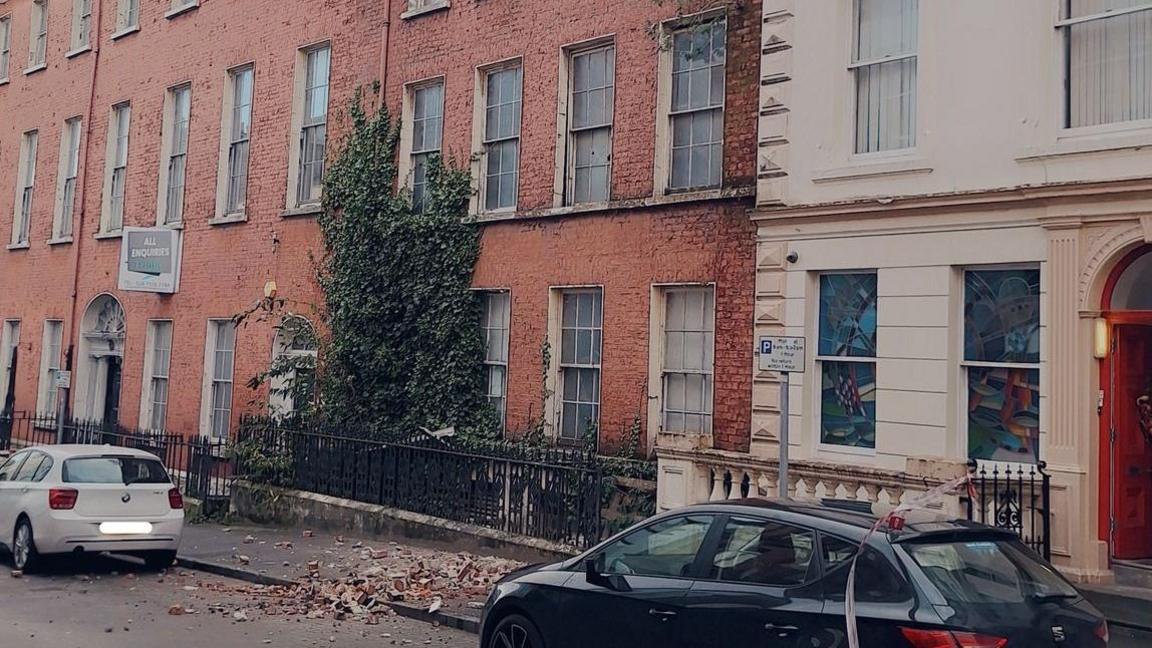Street still closed after bricks fall from Georgian building

Police released a photo showing a pile of bricks on the pavement below the Georgian building on Pump Street
- Published
A street in Londonderry remains cordoned off on Monday due to concerns over one of the city's most historic buildings.
A large hole can be seen on the facade of the former convent on Pump Street, a Georgian building dating back to the early 1800s, after bricks fell onto the pavement below.
Cordons are still in place at the junctions with Ferryquay Street and London Street.
SDLP councillor John Boyle, who chairs the council's planning committee, said it was important to assess the structural integrity of the building.

SDLP councillor John Boyle says the historic former convent must be protected

The photo shows a gap between two second-storey windows at the front of the building
"It's a very important part of our heritage, it's one of our oldest buildings here in our city conservation area," he told BBC Radio Foyle's North West Today programme.
"It's absolutely imperative that we protect it.
"The ambition would be to open the street as soon as possible."
John Anderson, from the Ulster Architectural Heritage Society, described it as "one of the finest" Georgian buildings in the city.
"It appears that a panel of brickwork between two of the wooden sash windows has, literally, been blown out onto the street," he said.

John Anderson, from the Ulster Architectural Heritage Society, says everything possible should be done to preserve the building
'Heart-breaking'
Trader Elaine Duffy, who visited the scene on Monday, said there were serious concerns over the building's future.
"It's heart-breaking for me to see the building falling apart like this," she said.
"Whenever we had the chemist's around the corner in Ferryquay Street, we would have been in with the nuns very often because they were actually our landlords.
"The big pain for me is to see all these old historic buildings left lying to rot."

Trader Elaine Duffy says she is concerned for the future of the former convent
Council staff 'liaising with the owner'
Council teams visited the site at the weekend in response to the incident.
A spokewoman said public health and safety was the priority and staff had been liaising with the owner of the building to ensure it is secured.
She added the council would continue to work with them and other statutory organisations in relation to the building.
Bishop Street community centre has been made available to any residents affected by the evacuation.
Listed building on 'at risk' register
The damaged property is a listed building which dates back to the 19th Century and now forms part of a complex of protected structures on Pump Street, near St Columb's cathedral.
The four-storey Georgian-era building was constructed in the early 1800s and once housed the offices of the Londonderry Sentinel newspaper.
For years, it sat next door to the oldest surviving building in Pump Street - the King's Arms Hotel.
The Catholic Church bought the adjacent hotel in 1840 and during the famine an order of nuns, the Sisters of Mercy, were asked to establish a convent at the site.
By 1890, the nuns were expanding their vocation in the city and so they acquired the former newspaper office building and incorporated it into their convent site.

Number 16 Pump Street (right) was a commercial building which became part of the convent next door in the late 19th Century
In the late 1970s, the convent became part of an architectural conservation area and in 1979 the complex was listed as a grade B protected building.
The Sisters of Mercy left the Pump Street site in 2005 and a few years later the buildings were briefly used as an antique and curiosity shop.
However, the former convent complex is now on the Department of Communities "Heritage at Risk" register, external which assesses the vulnerability of historic structures.
The listing stated that the site was in "very poor" condition and its level of risk was assessed as "critical".